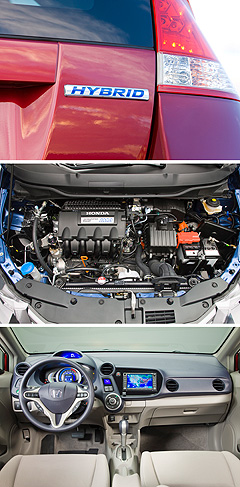Honda to have the cheapest hybrid
BY IAN PORTER | 13th Feb 2009

Honda Australia executive director Lindsay Smalley admits the Insight has not yet been confirmed for Australia, but he believes a big expansion of production capacity for Honda’s hybrid drivetrains makes it likely.
“We have made clear our desire to introduce the Insight to Australia in 2010,” Mr Smalley said today.
But pricing will be a thorny issue, as the Insight will have to fit under the Civic hybrid.
The Insight has gone on sale in Japan with a price of Y1.89 million (including the Japanese consumption tax) which, at today’s exchange rate, equals $A31,800. That would make it more expensive than all Civics bar the automatic Sport model and the Civic hybrid at $35,990.
The Civic hybrid always has been significantly cheaper than the Toyota Prius, the hybrid market leader, because the Honda hybrid system is simpler and easier to produce than the drivetrain in the Toyota.

The Toyota has two complete drivetrains, one petrol and one electric.
Mr Smalley said the cost of the Insight may not be an issue by the time it arrives in Australia.
“Don’t forget, all importers of goods from Japan will have to raise their prices if the Australian currency stays where it is,” Mr Smalley said.
Like many other car makers, Honda is putting its prices up by between two and three per cent every three months in a bid to bridge the gap caused by the sudden escalation in the value of the yen.
“If the dollar remains at around 60 yen, we will all need to raise prices of cars from Japan by 30 to 40 per cent.” Mr Smalley said a major focus during the development of the new Insight was the reduction of production costs and, ultimately, the selling price.
Honda has more than doubled its production capacity for its hybrid drivetrain system, called Integrated Motor Assist (IMA), to 250,000 systems a year. In 2007, Honda made 55,000 hybrids.
“Plus there have been cost-downs in the design process. The IMA system in the Insight is smaller, lighter and more powerful than the one used in the Civic.” The brushless electric motor, which is positioned between the engine and the continuously variable transmission, is 22 per cent thinner and 15 per cent lighter. It makes 10kW and lifts the total power available to 85kW.
“And there have been big gains in the battery design,” Mr Smalley said.
The latest generation of Honda’s nickel-metal-hydride batteries are 30 per cent more powerful. Honda has been able to reduce the size of the batteries by 31 per cent and their weight by 35 per cent while maintaining storage capacity.
Mr Smalley said he believed the price of the Insight would have to be attractive to buyers of non-hybrids if the company was to make headway in the market.
“The Civic hybrid appealed to passionate environmentalists who wanted to make a difference.
“If we can bring in the Insight at a lower cost (than the Civic hybrid) our potential audience will increase significantly.” While it is widely recognised that Toyota has not made any money on the 1 million Prius cars it has sold, Mr Smalley said he did not believe Honda had lost money on its hybrids.
“Honda, as a principle, tries to break even or make a profit when it sells cars.” He said Honda Australia had never had any trouble selling the limited allocation of 814 Civic hybrids it received each year.
Read more:
Detroit show: Honda gives hybrid InsightFirst look: An Insight into production